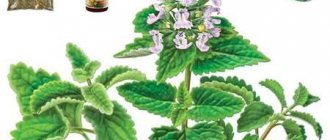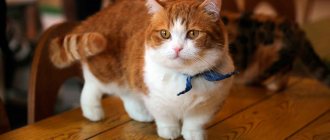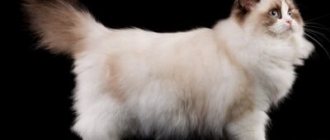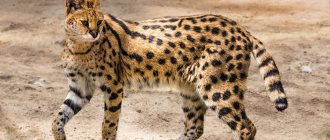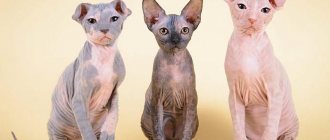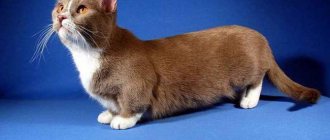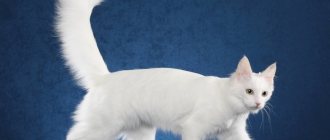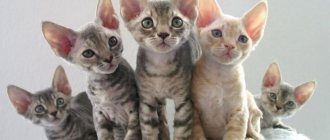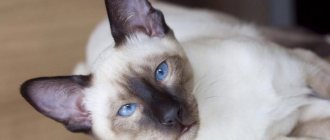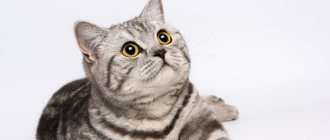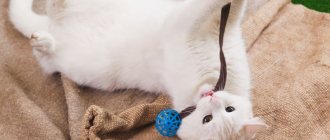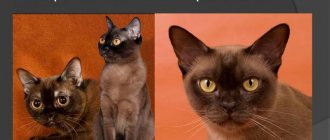Home » Cat Breeds
Classification Origin: was bred in the 60s of the last century in the USA (Pennsylvania)
Class: not classified
Color: white “socks” on the paws are required, the main colors are nut (silpoint), but a blue version (bluepoint) is also allowed, the percentage of white on the body is not higher than 65-70%.
Sizes: medium, males are slightly larger than females, weight from 2.5 to 5.5 kg
Life expectancy: from 9 to 15 years, on average – 12 years
Snowshoe is the cat you can only dream of. Spectacular, graceful, aristocratically restrained. Today we will tell you how to care for the nut beauty.
The snowshu in the photo immediately strikes you with its aristocracy. An amazing cat, everything about her is proportional, there is nothing superfluous.
There is a noticeable great resemblance to the Siamese. This is not without reason: the Snowshoe is a direct relative of the Siamese cat.
The breeds are very closely related, but differ in appearance and character. Let's get to know the “white legs” better.
- 2 Psychology
- 3 Application
- 4 How to choose a kitten
- 5 Features of care
- 6 Combing
- 7 Walking
- 8 Food
- 9 Health
- 10 Characteristic diseases
- 11 Vaccinations
- 12 Mating
History of the breed
The history of the breed began in the 60s of the last century in distant Philadelphia.
Dorothy Hinds-Doherty, a famous breeder of Siamese cats at that time, had one of the breeding females accidentally hanging out with a shorthaired spotted cat.
As a result, three lovely babies were born, looking like Siamese, but wearing charming white “shoes”.
The offspring turned out to be so beautiful and easy-going in character that the owner purposefully decided to breed more of the same kind.
As a result, a new breed appeared, which is still considered experimental; the standard was drawn up in 1980.
Its name “snow-shu” translates as “white shoe” and immediately reminds of something fabulous and magical.
The animal is the same: it amazingly combines soft grace, power, and aristocracy.
The Snowshoe breed captivates at first sight, but, unfortunately, is not particularly popular. Most often it is started in England.
Different color variations of snowshoe
Interesting! The unpopularity of whitelegs is explained by the strictest color requirements. Since recessive genes come out here, breeding pets is similar to Russian roulette: it is very difficult to guess what will happen in the end.
conclusions
The combination of flexibility and a strong body, points, luxurious white socks and a white spot on the face (in some) make them special and desirable cats. But a unique combination of factors also makes it one of the most difficult breeds to breed and obtain elite animals.
Because of this, they remain rare even decades after their birth. Three elements make Snowshoe breeding a challenge: the white spot factor (responsible for the dominant gene); acromelanic color (responsible for a recessive gene) and the shape of the head and body.
At the same time, the factor responsible for the white spots, even after years of selection, is the most unpredictable. If a cat inherits a dominant gene from both parents, it will have more white than if only one parent passes on the gene.
However, other genes can also influence the size and amount of white, so the influence is difficult to control and impossible to predict. In other words, it's difficult to get white spots in the right places and in the right amounts.
Add two more factors to this, and you get a genetic cocktail that produces very unpredictable results.
Psychology
Snowshoe kittens have a cheerful, playful character.
They become very attached to people. They have high intelligence and are capable of training.
In these cats you can notice the features of Siamese relatives and dogs: like the Japanese Chins and Pekingese , there is high devotion to the owner, understanding of his psychological state and mood.
Snowshoe kittens
Calm, friendly. Loneliness has a very bad effect on Snowshoe cats. In the photo you can see how the animal likes attention.
In general, they refuse to be alone and prefer to constantly be close to a person.
Ideal for families with children: they easily find a common language and frolic together with the kids.
If the owners go somewhere, leaving the pet alone, then they must be prepared to listen to the sad “story” of the animal about how bad it was.
But, unlike, for example, Burmese and Abyssinian cats , white-legged cats have a pleasant, quiet voice.
Snowshoes love to be photographed
Interesting! Surprisingly, many Snowshoe kittens, and then adults, simply love to swim. They, like Turkish Vans , are not at all afraid of water and can swim in a bath or pond, getting great pleasure from it.
Cats of this breed have a cheerful, playful disposition.
Unlike many other felines, they are not vindictive.
Don't be afraid: the slippers will remain dry, because your pet simply won't settle scores with you.
An affectionate, outwardly very beautiful animal, not at all whimsical in everyday life. And, although he really loves to be petted, he will not bother or impose himself.
Funny baby snowshoe
Interesting! Whitelegs are curious, incredibly smart animals. They easily climb to the highest places, and also, like Scottish Fold cats and Scottish Straight cats , easily master the techniques of opening latches and simple locks.
Therefore, barriers in the form of closed doors most often do not exist for them. In addition, they like to steal things they like and hide them.
In general, an ideal breed for keeping at home, the price of which is quite high, but it is worth it.
The animal is not only attractive in appearance, but also shows itself perfectly in terms of character and intelligence.
You can learn about other smart cat breeds here:
Character and behavior
The snow cat is surprisingly peaceful and balanced. Recognizes and listens to the owner, does not show aggression towards other animals or strangers. Can get along well with feathered neighbors and a dog. She is curious, smart, and has the ability to train.
A remarkable feature of a cat’s character is its sociability. The animal loves affection, but does not show excessive intrusiveness. If he feels that people are busy, he will not demand attention, he will climb onto some elevation and engage in calm contemplation of what is happening in the house. The cat's voice is quiet. An amazing feature of Snow White is that she is absolutely not afraid of water and bathes with pleasure.
She loves to play and is attracted to everything shiny. It would be great if your pet has exercise equipment, cat toys, and enough territory to play. Snowshoe is a typical city dweller. Feels great in the apartment. But even at the dacha, it will know its territory; with proper upbringing, the cat will never “walk on its own.”
Application
Snowshoe is a typical home dweller; it is best to keep her in city apartments.
It is easy to train, so you can raise an understanding animal that follows commands and does it with pleasure.
But it is recommended only for experienced “cat lovers” to breed beauties.
The fact is that not everyone succeeds in getting the right color.
The requirements for it are so strict that many kittens are rejected.
Beauty with bright blue eyes
The Snowshoe cat in the photo is a real beauty, reserved and at the same time ready to break into an exciting game at any moment.
By having her at home, you will get a true friend, affectionate and spontaneous.
Many professionals advise purchasing at least a couple of such pets, then the pets will better experience loneliness.
Upbringing
An active cat will be happy to learn a few simple commands and will carry them out if it understands that such actions bring joy to the owners.
The Snowshoe kitten quickly understands the rules of behavior, so it will not be difficult to train him to use the toilet and scratching post.
How to choose a kitten
Snowshoe kittens make you fall in love at first sight. They are charming, sweet, very beautiful.
But here it is important not to get carried away and not miss an obvious marriage. To prevent this from happening, carefully inspect the color.
White-legged cats are close relatives of the Siamese cat.
At the same time, the American Shorthair breed .
Breeding was based on recessive traits, which is why correct and clear coloring is so important. Examine the kitten you like.
An ideal representative of the snowshoe, seal point coloring
The basic color is similar to the traditional Siamese, and 2 variations are also allowed - walnut (“seal skin”) or blue.
Moreover, if the animal turns out to be two-color, no more than two-thirds of the entire body should be white.
Now the main signs. In high-quality cats and snowshoe cats, a white triangle on the face, shaped like an inverted V, is clearly visible in the photo.
Another important feature is the white socks on the paws, those same “shoes”.
The ideal option is the same on all four limbs. The eyes are always a pronounced blue color.
The color of the nose and fingertips is either pink or spotted to match the coat.
The color of the tail is uniform, in the same color scheme as the body, but much darker.
The Snowshoe cat in the photo is an ideal representative of the breed, which harmoniously combines all the described characteristics.
When choosing a kitten, consider all 4 signs of breed quality:
- White socks;
- White mark on muzzle in the form of an inverted V;
- Color typical of a Siamese cat;
- Correct physique (massive, but at the same time elongated, graceful).
Only one that combines all of the above characteristics will be considered a truly high-quality Snowshoe kitten.
That is why it is better to take an already grown individual, at the age of 2-3 months.
Focus on character too. Although absolutely all representatives of this breed are sociable and friendly, their activity may be different, this should be taken into account.
Important! The Snowshoe is a fairly rare breed, so you can easily make a mistake and get the wrong kitten. Be sure to study the pedigree. The best option is to meet the parents of the future pet, assess the compliance of the adult cats and the Snowshoe cat with the standards.
Description of Snow Shoe cats
global $ads_google;
//data-ad-slot=”2475549904″ $ads_google = empty($ads_google) ? false : true; ?> if ($ads_google == false) {?> $ads_google = true; ?> } ?> Snow Slippers are medium-sized animals. Usually their weight is approximately 4 kg, but in some individuals it can reach 6 kg. Cats are larger than female cats. The breed standard was adopted by the felinological organization TICA. If the animal meets these requirements, then this allows it to be considered purebred and show:
- Head
medium-sized, wedge-shaped. Its smooth contours resemble an isosceles triangle. The frontal bone is flat, the cheekbones are quite high. Viewed from the front, the muzzle is not wide and of medium length. But the mustache is large - from 5 to 12 cm.
- Ears
look harmonious and proportional with the head, and are a continuation of the wedge-shaped head. At the base, the auricle is wide, and towards the tip it evenly narrows, slightly rounding.
- Nose
the animal should not be wide. The bend at the level of the bridge of the nose is smooth, without a sharp angle. The standard allows for a small hump. The lobe matches the color tone. It can be pink and even spotted.
- Eyes
without bulge, medium size. Their cut has the shape of an oval, the contours of which are softly rounded and elongated in width. The outer corners point towards the ears. Eye color can be any shade of blue.
- Body
cats are well built and proportioned. The muscles are well developed, making the animal strong and active. The level of the pelvis is higher than the level of the shoulders. The spine is slightly arched. The skeleton is moderately developed, the animal does not look thick and massive.
- Paws
must be tall and graceful. Although the limbs are long, in general they look organically with the body of the animal.
- Tail
It is of medium length, tapering from base to tip.
The Snowshoe cat coat . The undercoat is very small, so the fibers lie close to the body. Thanks to this, the “athletic” figure of the cat is clearly visible. This breed is characterized by the same colors as the Siamese: seal and bluepoint, tortoiseshell. It is almost impossible to produce other colors.
The muzzle is decorated with a line filled with white. Also, these animals are often called “panda cats” because there are more dark fibers around the eyes, in the area of the shoulders and hips. The tail and paws of the pads are also black. But the “signature” feature of Snowshoe cats is the white shoes on the tips of their paws, which is why the breed got its name. A kitten's color can be completely snow-white, and the final color is formed only by two years.
Features of care
The good thing about the Snowshoe breed is that it does not require any very complex care.
The main thing is not to leave your pet alone for a long time, communicate with him.
In addition, it is worth brushing the beauty’s fur regularly.
The animal does not particularly need grooming, but if you wish, you can pamper your cat or cat by going to a specialist.
Whitelegs shed little, causing virtually no problems in this regard. By keeping them, you won't end up collecting clumps of matted wool all over the house.
But still, the hairline is quite dense, thick, and requires regular, if not daily, care.
Bathe the animal, many individuals love such procedures.
You can find out more about how to properly wash your cat here:
Important! If a cat has committed an offense, to find it, you just need to open the water. Representatives of the Snowshoe breed simply love to watch it flow. And to reduce theft to a minimum, give the furry criminal a few toys. The cat will gratefully play with them, like a dog, bringing them again and again for you to throw.
A characteristic white triangle is clearly visible on the Snowshoe's face.
In addition to fur, claws require care. Trim them regularly. It is worth purchasing or making a scratching post for an animal - it can also be an element of a cat house .
Keep an eye on your teeth. Experts recommend cleaning them, but not every owner dares to undertake such a procedure.
We advise you to visit a veterinarian: he will not only perform proper cleaning, but will also determine if your pet has any other problems.
The nursery is the result of the breeder’s own efforts
the fruit created by his labor is his passion, to which he devotes himself entirely, but it is also his round-the-clock work: without vacations, weekends and sick leave, without the right to give up or put it off for later.
Walk
The pet can be trained to walk with its owner, and the furry beauty does not mind a special cat collar.
On the street he behaves inquisitively, sniffs everything, quickly gets used to it and stops being afraid.
To avoid tick a protective collar on your pet .
Since the animal is a contact animal, you should never let it off the leash.
And one more condition: do not let your pet go for a walk with children. You can easily lose a rare pussy.
Curious cats
A more convenient option is to release the cat into the wild if you have a summer house.
The animal will actively explore the world without being afraid of it at all.
But keep an eye on him: he can easily run away.
Nutrition
In order for your Snowshoe cat to look as healthy as in the photo, it is important to feed it properly.
A balanced diet is the key to a long life and active behavior of an animal.
Healthy, beautiful white leg
Buy special food , and dry food can sometimes be varied with wet food.
We also recommend adding other foods: fresh green grass, boiled eggs (rarely), meat, fish.
If you don’t trust store-bought food and prefer to feed your pet only natural food, then be sure to include in your diet:
- Egg yolk (it is advisable to mix it with milk);
- Fermented milk products (exclude cream and sour cream; instead, kefir, fermented baked milk, yogurt are better);
- Raw oatmeal added to a main meal;
- Fruits and vegetables (raw or boiled);
- Sprouts of oats, wheat (sow in a pot, the cat will eat itself when needed, this will help her clear her stomach of hair);
- Special cat vitamins, in strict doses;
- Fresh meat, sea fish (obligatory boiled).
Nutrition for an animal is very important; it helps to maintain health and vigor.
Watch your drinking carefully: water should always be fresh and clean.
Important! Feeding a kitten is different from what is needed for adults. The baby should be given small portions, but often. As they grow, the volume should be increased and the number of feedings should be reduced. By the age of one year, the animal can be given food once a day, but so that it will last for a day.
The price of food varies, and here it is better to choose not expensive, but high-quality food.
We do not recommend giving only dry food, it can ruin the cat’s digestion.
Combine with wet options, or even better, with natural foods.
Also pay attention to the condition of your pet: there are special foods for animals during pregnancy , neutered and elderly cats.
Health
The Snowshoe cat looks healthy and cheerful - it’s all about proper care of the pet
The good thing about this breed is that it has virtually no concomitant diseases.
It is believed that with proper care, white-legged animals live fully into old age, practically without being exposed to any diseases.
If you are interested in looking at the scariest cat in the world, we recommend that you read the article
Still, you should take your pet to the veterinarian to immediately identify possible or existing problems.
In general, we can say that these are healthy, strong, active animals.
Characteristic diseases
The Snowshoe breed has practically no characteristic diseases.
If any problems may arise, they are only related to heredity.
There are not so many of them, and they are not as scary as other breeds:
- Strabismus. Usually congenital, inherited from Siamese relatives, rarely detected in kittens;
- Tail break. This is more of an external defect than a serious illness. It is also inherited from the Siamese.
No other health problems were noticed in the snowshoe.
Experts advise taking your animal to the veterinarian once a year so as not to miss any diseases, and for individuals over 8 years old - once every six months.
Reproduction
A difficult breed to breed.
Breeding the Snowshoe is the same as that of other breeds, with the exception of a number of points. Here, it is not the mating itself that is considered difficult, but the achievement of a standard color in the offspring. The fact is that kittens are rarely born with the exact pattern on their coat, so most are discarded. If the goal is not to get ideal representatives, but pretty cats with “white socks,” then the process is simplified.
Puberty in animals occurs during the first estrus (at 8-9 months). And the first mating is carried out only for the third time. Finding a suitable “groom” or “bride” for Snow-shu is difficult. It is recommended to look for it in the nursery where the kitten was purchased. You should not agree to offers on dubious advertisements.
What criteria are used to select a partner:
- Pedigree (all accompanying documents are required).
- Health and well-groomed appearance, availability of vaccinations. (confirmed by certificates from a veterinarian).
- Sexual experience.
- Appearance of a cat.
It should be taken into account that upon successful mating, one kitten from the litter is taken by the partner's owner. It is possible that he will ask for a monetary reward in return. Such issues are resolved in advance in writing. The desired birth rate for a cat is 2 times every 3 years. Frequent childbirth can lead to exhaustion of the animal’s body, which will affect future offspring.
Vaccinations
The Snowshoe breed requires routine vaccinations for animals, according to a standard schedule.
A kitten should be comprehensively vaccinated for the first time at the age of three months.
The procedure is then repeated every year.
In rare cases, the animal may be given an individual vaccination schedule .
Naturally, 10 days before the proposed vaccination, the animal should be dewormed.
Important! You cannot vaccinate kittens during the change of teeth (this is a period from 4 to 6-8 months), pregnant cats, and individuals with weakened immune systems.
Carefully monitor your pet's health.
At the slightest suspicion of any disease, it is best to immediately consult a specialist.
